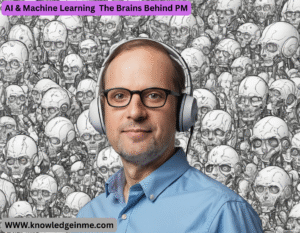Personalized Medicine Instead of a “one-size-fits-all” model, PM leverages advanced technologies like genomics, AI, and big data analytics to improve diagnosis, prevention, and treatment.
Key Components of Personalized Medicine
Genomics & Molecular Profiling
- Uses DNA sequencing (e.g., whole-genome sequencing) to identify genetic mutations linked to diseases.
- Helps predict disease risk (e.g., BRCA mutations in breast cancer) and drug responses (e.g., Warfarin dosing based on CYP2C9/VKORC1 genes).
Biomarkers & Diagnostics
- Identifies biomarkers (e.g., proteins, genes) for early disease detection (e.g., PSA for prostate cancer).
- Liquid biopsies detect circulating tumor DNA (CTDNA) for cancer monitoring.
Pharmacogenomics
- Studies how genes affect drug metabolism (e.g., CYP450 enzymes impacting antidepressant efficacy).
- Helps avoid adverse drug reactions (e.g., HLA-B*5701 testing before prescribing abacavir for HIV).
AI & Big Data
- Machine learning analyzes patient data (EHRs, wearables) to predict disease progression.
- IBM Watson and DeepMind assist in treatment recommendations.
Targeted Therapies
- Drugs designed for specific genetic mutations (e.g., EGFR inhibitors like gefitinib for lung cancer).
- CAR-T cell therapy customizes immune cells to fight cancer.
Applications & Examples
Oncology:
- HER2-positive breast cancer → Trastuzumab (Herceptin).
- PD-L1 testing for immunotherapy (e.g., Keytruda).
Cardiology:
- Genetic testing for familial hypercholesterolemia → PCSK9 inhibitors.
Neurology:
- APOE4 gene linked to Alzheimer’s risk → Early interventions.
Rare Diseases
- CRISPR-based therapies for sickle cell anemia.
Challenges
- High costs of genetic testing and targeted drugs.
- Data privacy concerns (handling genomic data).
- Ethical issues (e.g., genetic discrimination by insurers).
- Regulatory hurdles in adopting new technologies.
Future of Personalized Medicine
- Wearables & Digital Health: Real-time monitoring via smart devices.
- CRISPR & Gene Editing: Correcting genetic defects at the source.
- Microbiome Analysis: Gut bacteria’s role in drug response.
Advanced Genomics & Multi Omics Integration
- Beyond DNA sequencing, PM now incorporates multiple “omics” layers for a holistic view of disease:
- Epigenomics: Studies chemical modifications (e.g., DNA methylation) that regulate genes without altering the DNA sequence.
- Transcriptomics: Analyzes RNA expression to understand active genes in diseases like cancer.
- Proteomics & Metabolomics: Examines proteins and metabolic pathways to identify disease signatures.
- Example: Amyloid-beta and tau proteins in Alzheimer’s diagnostics.
- Future: Integration of multi-omics data via AI will enable ultra-precise disease subtyping.
AI & Machine Learning in PM
- AI is transforming PM by:
- Predictive Modeling
- Deep learning predicts drug responses (e.g., IBM Watson for Oncology).
Early Disease Detection
- AI analyzes retinal scans to predict cardiovascular risk.
- Chat GPT-like models assist in interpreting genetic reports.
Digital Twins:
- Virtual patient models simulate treatment outcomes before real-world application.
- Challenge: AI requires large, diverse datasets to avoid bias (e.g., underrepresentation of minority genomes).
CRISPR & Gene Editing Therapies
Gene editing is enabling next-generation PM:
- Ex Vivo Editing: Modifying cells outside the body (e.g., CAR-T cells for leukemia).
- In Vivo Editing: Directly correcting genes inside the body (e.g., VERVE-101, a CRISPR-based therapy for cholesterol).
- Base & Prime Editing: More precise than traditional CRISPR (e.g., correcting sickle cell anemia without double-strand breaks).
- Ethical Concerns: Germline editing (heritable changes) remains controversial (e.g., the He Jiankui CRISPR babies scandal).
Microbiome-Based Personalization
- The gut microbiome influences drug metabolism and disease:
- Fecal Microbiota Transplants (FMT): Treat C. difficile infections by restoring healthy bacteria.
- Pharmacomicrobiomics: Gut bacteria affect drug efficacy (e.g., irinotecan toxicity linked to certain microbes).
- Personalized Probiotics: Future therapies may use microbiome profiling to design custom probiotics.
- Challenge: Microbiome interactions are highly complex and individualized.
Liquid Biopsies & Early Cancer Detection
- Circulating Tumor DNA (CTDNA): Detects cancer mutations from blood (e.g., Guardant360, Grail’s GALLERI test).
- Minimal Residual Disease (MRD) Monitoring: Tracks cancer recurrence after treatment.
- Multi-Cancer Early Detection (MCED): Single blood tests screen for multiple cancers (still in validation).
- Limitation: False positives and high costs hinder widespread adoption.
Pharmacogenomics in Clinical Practice
Current Applications:
Drug Gene Effect
Warfarin CYP2C9, VKORC1 Dosing adjustment
Clopidogrel CYP2C19 Poor metabolizers need alternatives
Abacavir (HIV) HLA-B*57:01 Avoid in carriers (severe allergy risk)
Tamoxifen CYP2D6 Ineffective in poor metabolizers
Barrier: Only ~10% of FDA-approved drugs have pharmacogenomic guidelines due to limited evidence.
Ethical Legal & Social Implications ELSI
- Privacy: Genomic data breaches (e.g., 23andMe leaks) raise concerns.
- Genetic Discrimination: Laws like GINA (US) protect against insurance bias, but gaps remain.
- Health Disparities: PM may widen gaps if underserved populations lack access.
- CRISPR & Beyond: The Gene Editing Revolution
Current State of CRISPR in PM
FDA-Approved Therapies:
- CASGEVY (exa-CEL) – First CRISPR-based treatment for sickle cell disease and β-thalassemia (2023).
- Vertex’s VX-880 – CRISPR-edited pancreatic cells for Type 1 diabetes (in trials).
In Vivo Editing:
Verve Therapeutics’ VERVE-101 – A base editor targeting PCSK9 to permanently lower LDL cholesterol (early trials).
Next-Gen Gene Editing Tools
Technology Advantage Over CRISPR-Cas9 Potential PM Applications
Base Editing Converts single DNA bases without double-strand breaks Fixing point mutations (e.g., progeria, cystic fibrosis)
Prime Editing More precise, fewer off-target effects Correcting Huntington’s, Tay-Sachs disease
Epigenome Editing Silences/activates genes without altering DNA Cancer (MYC oncogene), autoimmune diseases
Challenges
- Delivery Systems: Getting editors into the right cells (lipid nanoparticles vs. viral vectors).
- Off-Target Effects: Even prime editors aren’t perfect.
- Ethics of Germline Editing: Should we ever edit embryos for disease prevention?
AI & Machine Learning: The Brains Behind PM
How AI is Transforming PM
Diagnostics:
- Paige.AI – Detects cancer in pathology slides better than human pathologists.
- Apple Watch’s AFIB detection – AI predicts stroke risk in real time.
Treatment Optimization:
- IBM Watson for Oncology (controversial but evolving).
- Tempus Labs – Uses EHR data to match cancer patients with optimal therapies.
The Next AI Frontiers in PM
- Generative AI for Drug Design: Models like Chat GPT for molecules (e.g., Bio GPT, ProtGPT2).
- Federated Learning: Hospitals share AI insights without sharing patient data.
- Digital Twins of Patients: Simulate drug responses before real-world trials.
Biggest Hurdles
- Bias in Training Data (most genomic datasets are from white Europeans).
- Black Box Problem – Can we trust AI’s decisions without explanations?
Next Gen Immunotherapies
- Neoantigen Vaccines – BION Tech’s mRNA cancer vaccines (personalized for each tumor).
- Bispecific Antibodies – Blinatumomab (for ALL) and newer variants targeting solid tumors.
- Microbiome-Modulated Therapy – Fecal transplants improve anti-PD-1 response in melanoma.
Biggest Challenges
- Resistance Mechanisms – Tumors evolve to evade immunotherapy.
- Cost – CAR-T therapy runs >$500,000 per patient.
Nanomedicine: Tiny Tech for Precision Delivery
Current Applications
- Liposomal Doxorubicin (DOXIL) – Targets tumors while sparing the heart.
- mRNA COVID Vaccines (Pfizer, MODERNA) – Lipid nanoparticles deliver genetic instructions.
Future Directions
- DNA Nanorobots – Seek and destroy cancer cells (early animal studies).
- Quantum Dots – Ultra-precise imaging of tumors during surgery.
- Smart Pills – Ingestible sensors track drug effects in real time.
Obstacles
- Toxicity – Some nanoparticles trigger immune reactions.
- Manufacturing Complexity – Hard to scale up.
The Future: Speculative but Possible Breakthroughs
- Age Reversal Therapies – SENOLYTICS + epigenetic reprogramming (Altos Labs, Calico).
- Brain-Computer Interfaces (BCIs) for Neuro-PM – NEURA link-like tech to treat epilepsy, paralysis.
- Synthetic Biology – Engineered microbes that live in the gut and secrete drugs on demand.






